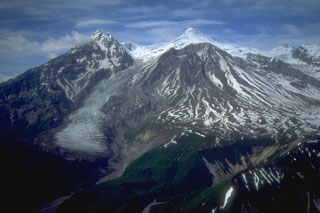Report on Spurr (United States) — 16 October-22 October 2024
Smithsonian Institution / US Geological Survey
Weekly Volcanic Activity Report, 16 October-22 October 2024
Managing Editor: Sally Sennert.
Written by Kadie L. Bennis.
Please cite this report as:
Global Volcanism Program, 2024. Report on Spurr (United States) (Bennis, K L, and Sennert, S, eds.). Weekly Volcanic Activity Report, 16 October-22 October 2024. Smithsonian Institution and US Geological Survey.
Spurr
United States
61.299°N, 152.251°W; summit elev. 3374 m
All times are local (unless otherwise noted)
The Alaska Volcano Observatory (AVO) reported that low-level unrest at Spurr was ongoing, characterized by elevated seismicity and deformation, and minor gas-and-steam emissions were visible in webcams. A small lake was present in the summit crater during 15 May to 15 June. The Volcano Alert Level was raised to Advisory (the second lowest level on a four-level scale) and the Aviation Color Code was raised to Yellow (the second lowest level on a four-color scale) at 1237 on 16 October.
Geological Summary. Mount Spurr is the closest volcano to Anchorage, Alaska (130 km W) and just NE of Chakachamna Lake. The summit is a large lava dome at the center of a roughly 5-km-wide amphitheater open to the south formed by a late-Pleistocene or early Holocene debris avalanche and associated pyroclastic flows that destroyed an older edifice. The debris avalanche traveled more than 25 km SE, and the resulting deposit contains blocks as large as 100 m in diameter. Several ice-carved post-collapse cones or lava domes are present. The youngest vent, Crater Peak, formed at the southern end of the amphitheater and has been the source of about 40 identified Holocene tephra layers. Eruptions from Crater Peak in 1953 and 1992 deposited ash in Anchorage.
Source: US Geological Survey Alaska Volcano Observatory (AVO)

